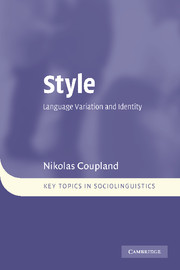Book contents
- Frontmatter
- Contents
- List of figures and tables
- Preface and acknowledgements
- Transcription conventions
- 1 Introduction
- 2 Style and meaning in sociolinguistic structure
- 3 Style for audiences
- 4 Sociolinguistic resources for styling
- 5 Styling social identities
- 6 High performance and identity stylisation
- 7 Coda: Style and social reality
- References
- Index
6 - High performance and identity stylisation
Published online by Cambridge University Press: 14 May 2010
- Frontmatter
- Contents
- List of figures and tables
- Preface and acknowledgements
- Transcription conventions
- 1 Introduction
- 2 Style and meaning in sociolinguistic structure
- 3 Style for audiences
- 4 Sociolinguistic resources for styling
- 5 Styling social identities
- 6 High performance and identity stylisation
- 7 Coda: Style and social reality
- References
- Index
Summary
THEORISING HIGH PERFORMANCE
It would be apt to invoke the idea of performance as a quality of most and probably all of the styling practice we have considered in the book so far. There has been a tendency in linguistics to strip away any specific meaning for the term ‘performance’, by virtue of Noam Chomsky's long-standing but sometimes-disputed distinction between linguistic competence and linguistic performance. One of the founding ideas in sociolinguistics was to challenge the idea that language in use could be dismissed as ‘mere performance’, if that notion implied everyday language use or actual behaviour. As we saw in Chapter 1, a concept of ‘everyday language’ has been important to sociolinguistics since its inception, even though that concept has raised interpretive difficulties of its own. Chomsky's corresponding emphasis on linguistic competence, speakers' knowledge of the linguistic system, ignored the social dimension of language that is at the heart of sociolinguistics. I have already referred to communicative competence as Dell Hymes's alternative formulation (see section 4.6). Alessandro Duranti (1997: 14ff.) discusses this complex of issues in detail. But once we recognise speakers' agentive role in constructing meanings in how they contextualise variation, and when we also recognise that speaking involves a degree of metalinguistic awareness (see section 4.5), it seems right to talk of speakers performing speech. What we are generally implying is that speakers design their talk in the awareness – at some level of consciousness and with some level of autonomous control – of alternative possibilities and of likely outcomes.
- Type
- Chapter
- Information
- StyleLanguage Variation and Identity, pp. 146 - 176Publisher: Cambridge University PressPrint publication year: 2007
- 1
- Cited by

